Columbine care and growing guide: expert tips on aquilegia
Learning how to grow columbine is essential if you want beautiful, healthy plants which give months of color from late spring
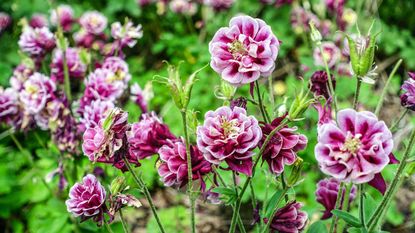

Following the right columbine care tips will ultimately provide you with very distinctive perennial flowers, some of which are amongst our prettiest natives. Also referred to as aquilegia, they bloom in late spring and summer but most live for only a few years before fading away. They are, however, very easy to grow from seeds.
The columbine is one of those few flowers that come in a literal rainbow of colors. There is even one with chocolate-colored flowers. In many varieties the flowers bring together contrasting colors for a dazzling look. Columbines are visited by bees and other pollinating insects, and are also popular with hummingbirds.
Typical columbine flowers have five flat outer petals. These petals surround five more rounded petals that make up the skirt, and which each have a slender tube at the base that contains the nectar and protrudes upwards between the outer petals. The flowers are usually nodding. Modern varieties often bring us variations on this look. They are often easier to recognize than to describe!
The flowers are carried on stiff upright branched stems in late spring/early summer, growing through very attractive mounds of green or grayish green foliage divided into nine, or sometimes more, rounded leaflets.
Learning how to grow columbines so you can incorporate them into your flower bed ideas will almost guarantee low-maintenance color to a variety of garden spaces. Beth Chatto, garden writer and expert gardener wrote: 'Aquilegias are excellent and easy garden plants, with a variety of colors and forms to suit any open situation, they will grow in part shade also.'
Choosing columbine flowers for your plot
It helps to think about columbines by dividing them into three different groups. All produce generous quantities of both pollen and nectar and, if they shed their seeds, the seeds will often sprout and give you new plants in your garden borders.
- Garden columbines: Are derived from native columbines. They tend to bloom for longer, with larger flowers and more of them in a dazzling range of colors and especially in combinations of bright shades. Good for mixed borders, they are ideal for working into your landscaping with flowers. For garden columbines, they will be happy in more sun than many native columbines. These too will shed seed that often sprout. Look for ‘McKana’s Giants’, the Songbird Series, the Swan Series, or the Winky and Double Winky Series with upward facing flowers.
- Cottage garden columbines: Sometimes called granny’s bonnets, cottage garden columbines have masses of petals crowded into the flower. The flowers of rose columbines are a little like a small flat rose, ‘Ruby Port’ is a good example, pink-and-white ‘Nora Barlow’ and the other colors in the Barlow Series are similar. ‘Double Pleat’ and varieties in the Bonnet Series have crowded pleated flowers in a range of generally softer colors. These too will produce seedlings.
- Native columbines: Different wild US-native columbines grow in different parts of the country. For example, in the west we find western columbine (Aquilegia formosa) while red columbine (Aquilegia canadensis) grows in the east. These are good plants for shade gardens, and native gardens, and will pop up and bloom wherever they are happy.
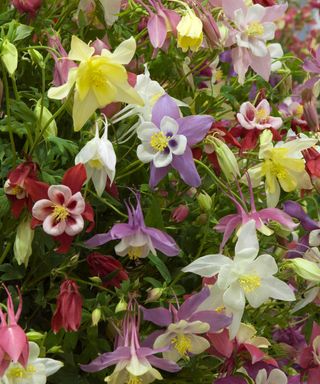
Easy to grow and raise from seed, ‘Songbird Series Mixed’ are garden columbines
Garden and cottage garden columbines make some of the best cottage garden plants for classic English style borders, between roses, and also for large planters. If you are looking for a blaze of eye-catching color choose one of the mixtures of colors such as the ‘McKana's Giants’. On the other hand, for a more sophisticated look, go for columbine plants in specific colors such as ‘Nora Barlow’ or the chocolate-colored Aquilegia viridiflora.
If you prefer a more natural style and easier columbine care, then choose one of the varieties that is native to your part of the country.
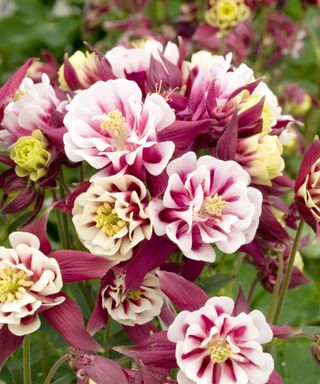
‘Winky Double White-Red’ is ideal for mixed borders where the upward-facing flowers can be easily seen
Where to plant columbines
In general, if you're looking at how to grow columbines in cooler areas, choose a site in full sun. Farther south, your garden columbines and cottage garden columbines will grow better as shade-loving plants.
Native red columbines and western columbines are happiest in partial shade but the seeds will often spread around your yard and will grow best where they are happiest.
Fertile, but well-drained conditions are usually most suitable but columbines will often pop up and flower well in unexpected situations.
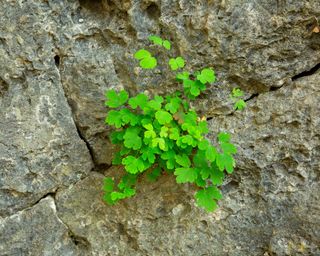
Aquilegias often pop up in walls and cracks in paving
When to plant columbines
Planting columbines is usually a spring garden job. Although winter is suitable in mild areas if the ground is not frozen or waterlogged.
Plants sold in flower can be planted as soon as you get them home, or kept in their pots until flowering fades. An important part of columbine care for plants sold in flower, is to cut them back hard when you get them home and plant them in mid to late summer.

Plant young columbine specimens in spring, or larger plants mid to later summer after flowering
Columbine care tips
To encourage a long flowering season, snip off the flower stems at the base as soon as the petals have dropped. This will also prevent seed falling and sprouting – otherwise, you may be overwhelmed with columbine plants.
When blooming is over you can also cut back the leaves to the base. This will stimulate a fresh burst of attractive foliage plants but it is important that your columbines do not dry out at this stage.
After two or three years, plants tend to fade away and you will need to replace them. You may be tempted to dig up and split your aquilegia into two or three pieces. This very rarely works.
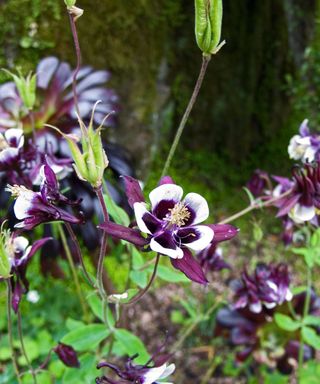
Snip off stems at the base as soon as flowers fade
Cutting back columbines
Garden varieties and cottage garden varieties are best cut back hard after flowering. Simply gather all the foliage in one hand, exposing the leaf stalks, and use your pruning shears (also known as secateurs in the UK) or even the kitchen scissors, to cut just above soil level with the other. It is, however, important that at this stage they are never allowed to dry out. This is also a convenient way of stopping any bug infestations in the early stages.
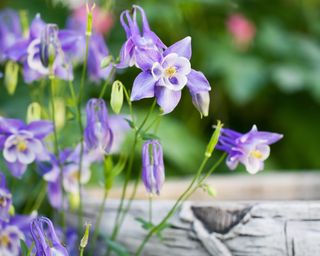
Cut your columbines back to the base after flowering
Columbine problems and how to solve them
In Europe a serious fungus disease, aquilegia downy mildew, has attacked columbines and in some gardens they are now impossible to grow. This disease is not yet established in North America.
Caterpillars sometimes eat the leaves and can decimate a plant very quickly, so be ready with your favorite treatment. Tiny grubs may also tunnel under the surface of the leaves, and in this instance the infested leaves are best snipped off.

Curling leaves with yellow and purple patches are symptoms of aquilegia downy mildew
Can you grow columbines in pots?
Yes, columbine flowers can be grown as part of your container gardening ideas, either in a mixed planting arrangement with other plants or as specimens. The larger the planter, the larger the varieties that look right. Their flowering season is limited to a few weeks in early summer, unless you're deadheading flowers rigorously, but the fresh summer foliage fills in prettily around other plants.
Dwarf types, such as the Earlibird Series and the upward facing Double Winky Series make attractive specimens in 10-12in (25-30cm) pots as patio plants for your decking ideas. After flowering, if fed and watered well, their new foliage makes a very decorative mound.

Aquilegia canadensis ‘Little Lanterns’ - feed and water well in pots
What USDA zones do columbines grow in?
Columbines can take very low winter temperatures so the Origami Series, the Songbird Series, the Swan Series, as well as red columbine (Aquilegia canadensis) will take USDA zone 3.
Cottage garden columbines such as the Bonnet Series, the Barlow Series and the McKana’s Hybrids will take zone 4 along with the western columbine (Aquilegia formosa) and most other columbines.
Are columbines deer resistant?
Yes. So it's worth learning how to grow columbines for the most colorful of deer resistant plants. The foliage and the roots are toxic to deer and the deer know not to eat them. Columbines are also rabbit resistant.
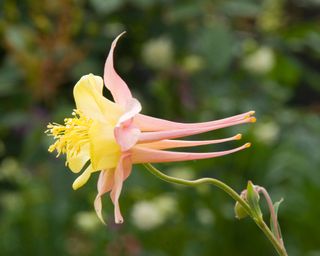
Free-flowering aquilegia ‘Origami’
Which are the best wild columbine flowers?
There are about 30 different wild native columbines in America and Canada. Some are rare and only grow in a small area, other native columbines grow naturally over a much wider area.
This is a case where it is wise to choose the columbine that is native to your area. For example, red columbine (Aquilegia canadensis) grows wild over the north east, south east and mid-west. In the south west and north west, the western columbine (Aquilegia formosa), at twice the height and with bluer, more deeply lobed leaves, is native. The Colorado columbine (Aquilegia coerulea), grows south from Wyoming.
Wild columbines are mostly pollinated by hummingbirds, and it is interesting to note that in the east, there is one very widespread wild columbine, and one kind of hummingbird. In the west there are far more different kinds of columbines, and also far more different hummingbirds.
Are aquilegia and Columbine the same?
Many plants will have both a scientific name and also a common name. In this case, aquilegia is the scientific name for these early summer and late spring flowering plants. Columbine is the common name.
Where to buy columbines
Columbines are available either as seed, as young plants or as plants in flower. Seeds are available in retail nurseries, from mail order suppliers and from native plant specialists. Your plants will usually flower a year after you sow the seeds. They are easy to raise, so this is the most economical approach.
Young plants are available by mail order in pints. Larger plants, in flower, are often available from retail nurseries and DIY stores. And of course there are multiple choices of columbines available online.
Where to buy columbines in the US:
- Shop columbines at Amazon
- Shop columbines at Burpee
- Shop columbines at Diane's Seeds
- Shop columbines at Lowe's
- Shop columbines at Summer Hill Seeds
- Shop columbines at Swallowtail Garden Seeds
- Shop columbines at Walmart
Where to buy columbines in the UK:

Graham Rice is a garden writer who has won awards for his work online, and in books and magazines, on both sides of the Atlantic. He is a member of a number of Royal Horticultural Society committees and the recipient of the 2021 Garden Media Guild Lifetime Achievement Award.
-
 Do you need to chit potatoes? Find out what the experts say
Do you need to chit potatoes? Find out what the experts sayGrow Your Own Learn how to chit potatoes before planting them in the ground and you’ll be on your way to getting an earlier and bigger harvest
By Drew Swainston Published
-
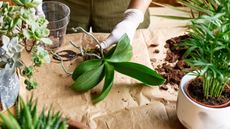 What causes orchid root rot and how do you solve it?
What causes orchid root rot and how do you solve it?Plants Discover the causes of orchid root rot so you can prevent this common problem from killing your plant
By Sarah Forsyth Published
